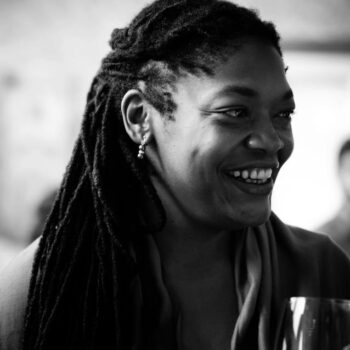During the final minutes of the first training session I’d ever run, a person in his early teens said something along the lines of, “I can’t believe we already knew how to do all of this.” The “this” was grassroots fundraising, and his line wasn’t one of frustration (why did you waste our time?) but of recognition (this isn’t so hard, and we can apply what we already know to raise money). I didn’t know what popular education was then, but that moment was foundational to my appreciation of it. This teen hadn’t just picked up new skills; he also had picked up a new appreciation for what he brought to the table, just by virtue of being him.
This kind of transformation is at the heart of popular education, and it’s essential to building an equitable future — especially for base-building organizations. Yet, far too often, popular education is put in the category of “nice to haves,” like t-shirts printed in multiple colors or a new campaign-specific banner. It’s time to recognize that popular education is far more than an add-on; this people-guided model is in fact central to helping build and wield the power necessary for transformative change.
What We Talk About When We Talk About Popular Education
Founded and popularized by Brazilian educator Paolo Freire, popular education is a modality of teaching — a “how” more than a “what.” It is the antithesis of the passive approach to education, in which students are empty vessels waiting to be filled by the wisdom of a lecturer at the front of the room. Popular educators see participants as co-creators of their learning who can draw from their lived experiences to interrogate problems and develop solutions. Consequently, popular education is interactive, oriented toward taking action and designed to spur creative problem-solving. Noelle Wiggins refers to popular education as “organized action to change the world.” In practice, popular education consists of using the experiences of the people in the room; identifying patterns from those collective experiences; incorporating new information; providing space for people to practice their skills; and putting that knowledge into action. 
In the progressive world, the term is often used interchangeably with political education, but the two are not comparable. That’s because political education centers on its content — it is more “what” than “how.” To be clear, political education isn’t exclusive of popular education. If you want to convey the benefits of ranked choice voting or the mutual aid components of the Black Panther Party, you could just as easily stand at a lectern delivering a monologue as you could opt for a popular education approach, grounded in the experiences in the room. The difference is in method more than content. Popular education uses a horizontal learning structure in which everyone in the room is both teacher and student, no matter the issue being addressed.
The rise of virtual trainings over the past two years has blurred the line even more, since an increasing number of tools can be used for both popular and political education. One such example can be found in a microsite that my organization, Take on Wall Street, launched in September 2020 in an effort to adapt to our new virtual world. We started with our most visually engaging training module, our gallery viewing. The gallery was designed to take people through key moments in the country’s history because we believe that we can’t fix the problems we face without understanding their roots. The result, isoureconomyfair.org, looks at wealth extraction in our economy from colonization to the present day, using race and gender lenses.
Since it exists on the web, English speakers around the world can access the site and go through its 14 galleries to uncover some of the lowlights of US history. They can, at their convenience and own pace, learn (or be reminded) how:
-
soon after emancipation, multiple Alabama counties made it illegal to sell cotton after dark so that they could arrest Black people and assign them to plantation labor;
-
the Chinese Exclusion Act disenfranchised thousands of people by making them ineligible for citizenship for over half a century;
-
hundreds of thousands of US citizens of Mexican descent were forcibly “repatriated” in the 1930s; and more.
The site is compelling, with content that is both horrifying and engaging. And it’s gorgeous to boot. Nonetheless, in and of itself, it is not popular education. It is political education. The site only becomes a popular education tool when participants in a (virtual) workshop are able to use their experiences, identify patterns, incorporate new information, practice their skills, and put their knowledge into action.
PE Takes Down PE: Popular Education Fights Back Against Private Equity
As proud as I am of how isoureconomyfair.org turned out, I’d never argue that popular education requires a fancy platform. There are countless ways to apply popular education strategies because their foundation is horizontal learning. For example, United For Respect organizer Aliya Sabharwal relied on popular education in the organization’s fight against the private equity behemoths that bankrupted Toys ‘R’ Us (TRU). When TRU shuttered its doors in 2018, the dominant narrative was that it had fallen prey to Amazon. In fact, it was a trio of private equity firms that caused the country’s third largest retail bankruptcy ever. The firms went on to refuse payment of the $75 million in severance pay they owed 33,000 employees.
Early in a campaign to secure severance payments, Sabharwal recognized that members were developing an analysis of what had happened at TRU based in their own observations, including sudden changes in how orders were placed or inventory that didn’t track with expectations. This analysis was deep enough that one leader was able to educate a reporter on what a takeover looks like. Sabharwal ran popular education workshops that helped workers build a shared analysis and land on the key points and phrases that resonated the most, like the frame that the system is rigged. This data then shaped the campaign’s communication strategy.
Popular education also helped build a culture of curiosity among the leaders. They wanted to learn more about the standard array of tactics used in online-to-offline organizing, from how to tweet at members of Congress to the best practices for engaging workers online. Leaders requested training on the nitty-gritty of a leveraged buyout, what it looks like to introduce legislation, and how Congress works. They organized presidential debate watch parties because they wanted to see how the candidates talked about Wall Street, if at all. In this way, leaders developed common sense language to describe the financialization of the retail sector. Being able to break down little-known concepts, like the structure of private equity deals, was critical in extending the campaign’s base of supporters because it made the stakes, winners, and losers that much clearer.
Such co-learning created a virtuous cycle of increased commitment and increased engagement. In part because of popular education, one full-time organizer built a central committee of 30 leaders, which grew over two years to 50-60, ultimately requiring additional staff for what became a base of over 11,000 workers. These workers made use of digital and in-person actions, with strategies that included posting photos the week their stores were liquidating with messages calling for the severance they were owed; tweeting and calling in to the headquarters of PE firms demanding that they pay out severance; visiting the small reopening of TRU (called Geoffrey’s Toy Box) to take photos with messages calling for severance; and multiple in-person rallies. When the Stop the Wall Street Looting Act was introduced in Congress, over 50 leaders were present. The campaign also had over 60 media spokespeople — another testament to its member engagement.
Former TRU employees held more than 150 actions in 20 states, ultimately winning a landmark $20 million for a financial assistance fund. While far less than the amount owed to the workers, the fund marked the first time a private equity firm paid anything to the workers of a company it bankrupted. No less important, the campaign helped raise the profile of private equity in the public arena, paving the way for the Stop Wall Street Looting Act, introduced in the last Congress and designed to protect workers, investors, and communities from the worst aspects of the private equity model.
Could UFR have won without using popular education to further develop its base and leadership? Very possibly. And doing so would have built power of a sort. The organization’s reputation and capacity would have grown, increasing its institutional power. And TRU members and leaders would have experienced the pride of victory. They also would have walked away with technical know-how on things like using Facebook to organize and developing strategies for bringing in more members and moving them up the ladder of engagement. But they wouldn’t have necessarily left with a sense that, regardless of their academic or educational experiences, they have expertise that can guide and shape winning campaigns.
To put a finer point on it, by validating people’s experiences, popular education helps them deepen their consciousness of their role as actors capable of effecting change. Here’s what Sabharwal thinks popular education produced for TRU leaders:
This is now a community of folks who are engaged. They’re not just responding to outreach when it’s time for a primary, but they’re trying to learn about the world and figure out which politicians are working for them. In many ways, the win was having a group of people identify as activists to rein in Wall Street greed — and to be really passionate about that based on their lived experience. That’s not a way they would have identified prior to the campaign. I just think that’s transformative.
I agree. Campaign wins are important. But true liberation comes when the people have the power. As Friere wrote, “Attempting to liberate the oppressed without their reflective participation in the act of liberation is to treat them as objects that must be saved from a burning building.” Objects don’t have power. But organized people who see themselves not as mere spectators but as co-creators of their lives are a force to be reckoned with. And popular education is a key strategy for building that power.

